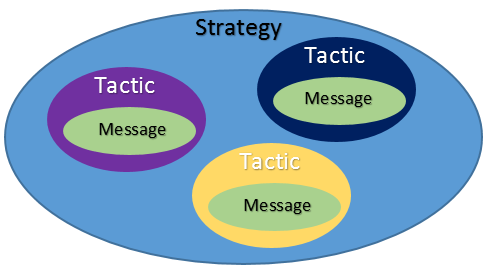This is part one of a three part series about communication strategy. This information is largely adapted from a paper I wrote for a class taught by Peter Schechter of Chlopak, Leonard, Schechter and Associates at The George Washington University.
When you hear nonprofit association director say something like, “Our strategy is to host a conference with all the industry leaders,” you should respond, “Great tactic, but what is your strategy?”
Strategy, Messages, & Tactics

Strategy is the overarching term; different tactics are represented with different colors. However, the message should remain the same between tactics, so it is represented in green throughout the diagram.
Strategy is not an event, a tactic, longer than two minutes to describe, or a secret. A strategy is a road map to accomplishing an objective, boundaries for consistent and disciplined action, means of ensuring proactive communication, and a policing mechanism. Strategy understands that everything communicates from the expression the receptionist has to the type of detergent the company uses for office cleaning. The key to developing a strategy is to determine your organization’s objective. Once your association has a clearly written objective, you can begin to develop messages and tactics.
What is a message? A message is what people hear, but a good message is what people hear again and again. Messages should have consistency, reciprocity, social validation, authority, and scarcity. In today’s world, people don’t want sit through a two and a half minute commercial about a Jeep detailing all of its features. Instead, people respond to messages that are short, that uses phrases instead of sentences, and that are value driven. Messages should use the language of the audience—small simple words. Associations consistently do well with messaging in their mission statements, but be sure to repeat it throughout your website, on social media, at your events, and in any advertising!
Tactics are an entirely different entity. Tactics are specific actions that are consistent with the strategy, and they repeat the message. An example of a tactic is when big Internet pages such as Wikipedia, Google, and Amazon blacked out to protest SOPA and PIPA. Blacking out was the tactic; the message was SOPA and PIPA will prevent freedom of the Internet; and the strategy encompassed both of those with the objective to prevent SOPA and PIPA from passing. Tactics such as these are beneficial to associations; often times lobbying on behalf on an industry requires tactics that call on the attention of legislators.
Voice, Creative Flair, & Appropriateness
Some components of determining the appropriate strategy, message, and tactics are: voice, creative flair, and appropriateness. The purpose of these elements is to spur action in stakeholders–a topic I will discuss in part two. A message will be lost in the noise if it does not ring true, relevant, unique, and appropriate.
Voice is all about who is delivering the message. The president of your nonprofit association is often not the right person to be speaking because of course the group that’s mission is to lobby for corn growers will be against legislation that ends government subsidizing of farms. Your president’s statements will not seem authentic to policymakers. However, there are many other organizations effected by the price of corn: truck drivers, grocers, restaurants, etc. It is important to create an echo-camber of support for your message from other stakeholders–repetition is important.
Creative flair is what makes a message stand out from the rest. No longer will an issue gain attention from a press release. A company must step out of the box. When Ben and Jerry’s first began as a small company in Vermont, they wanted to show their customers their greatest value: fun. They began the annual fair with rides, games, and ice cream (of course!). They also began annual free cone day to celebrate the end of winter. Both of these traditions carry on today, showing the creative flair and passion for fun that Ben and Jerry founded the ice cream company on. The creative flair of a message does not have to be as elaborate or expensive as the famous ice cream company’s, but it does need to be unique and catch potential stakeholder’s eyes.
Appropriateness encompasses the potential problems of going too far with creative flair. Messages must match the audience, have the appropriate look and feel, and be culturally and socially appropriate. Following a scandal that involves your industry, do not have a knee jerk response; take the time to test the messages so your association will gain support, not embarrass and lose clients for your members.
Featured image by greeblie on Flickr; charts created by Abigail Smith

